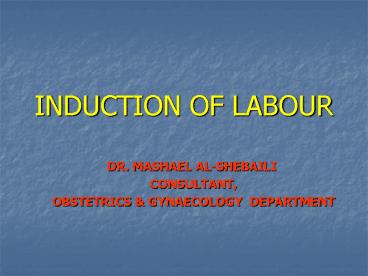INDUCTION OF LABOUR PowerPoint PPT Presentation
1 / 11
Title: INDUCTION OF LABOUR
1
INDUCTION OF LABOUR
- DR. MASHAEL AL-SHEBAILI
- CONSULTANT,
- OBSTETRICS GYNAECOLOGY DEPARTMENT
2
INTRODUCTION
- DEFINITION ?Induction of labour is defined as an
intervention designed to artificially initiate
uterine contractions leading to progressive
dilatation and effacement of the cervix and birth
of the baby. This includes both women with
intact membranes and women with spontaneous
rupture of the membranes but who are not in
labour.
3
- INDICATIONS
- Post-term pregnancy ? most common
- PROM
- IUGR
- Non-reassuring fetal suvillence
- Maternal medical conditions ? DM, renal disease,
HPT, gestational HPT, significant pulmonary
disease, antiphospholipid syndrome - Chrioamnionitis
- Abruption
- Fetal death
4
- RISKS of IOL
- ? rate of operative vaginal deliveries
- ? rate of CS
- Excessive uterine activity
- Abnormal fetal heart rate patterns
- Uterine rupture
- Maternal water intoxication
- Delivery of preterm infant due to incorrect
estimation of GA - Cord prolapse with ARM
5
- CONTRAINDICATIONS
- (Contraindications to labor or vaginal delivery)
- Previous myomectomy entering the cavity
- Previous uterine rupture
- Fetal transverse lie
- Placenta previa
- Vasa previa
- Invasive Cx Ca
- Active genital herpes
- Previous classical or inverted T uterine incision
- 2 or more CS
6
- PREREQUISITES
- To assess the following
- Indication / any contraindications
- GA
- Cx favourability (Bishop score)
- Pelvis, fetal size presentation
- Membranes status
- Fetal heart rate monitoring prior to IOL
- Elective induction should be avoided due the
potential complications
7
Cx ripening prior to IOL
- Indication ? if the Bishop score is 6
- The state of the Cx is an important predictor of
successful IOL - Methods
- Intracervical PGE2 gel ?0.5 mg/6hrs----3 doses
- Intravaginal PGE2 gel ?1-2 mg/6hrs----3doses
- PGE2 gel ? the rate of not being delivered
in 24 hrs - ? the use of oxytocin for
augmentation of labor - PGE2 gel ? the rate of uterine
hyperstimulation - Misoprostol ? Should not be used for term fetuses
- Mechanical methods
8
Cx ripening prior to IOL
- Mechanical methods
- Foley Catheter
- It is introduced into the cervical canal past the
internal os, the bulb is inflated with 30-60 cc
of water - It is left for up to 24 hrs or until it falls out
- Contraindications ?Low laying placenta,
antepartum Hg, ROM, or cervicitis - No difference in operative delivery rate, or
maternal or neonatal morbidity compared to PG gel
- Hydroscopic dilators (Eg.Laminaria tents)
- Higher rate of infections
9
IOL
- 1-Oxytocin with Amniotomy
- IV
- Half life 5-12 min
- A steady state uterine response occurs in 30 min
or gt - Fetal heart rate uterine contractions must be
monitored - If there is hyperstimulation or nonreassuring
fetal heart rate pattern ? D/C infusion - Women who receive oxytocin were more likely to be
delivered in 12-24 hrs than those who had
amniotomy alone - less likely to have operative delivery
10
IOL
- 2-PGE2
- For women with favorable Cx ? PGE2 ? the rate of
operative delivery failed IOL when compared to
Oxytocin - PGE2 ? ? GIT side-effects, pyrexia uterine
hyperactivity - 3-Sweeping of the membranes
- Vaginally the examining finger is placed through
the os of the Cx swept around to separate the
membranes from the lower uterine segment - ? ? local PGF2 a production release from
decidua membranes ? onset of labor - ? the rate of delivery in 2-7 days
- ? the rate of post-term
- ? the use of formal induction methods
- If there is urgent indication for IOL sweeping is
not the method of choice
11
Specific circumstances or indications
- Prelabor SROM at term
- 6-19
- IOL with oxytocin ?? risk of maternal infections
(chorioamnionitis endometritis) neonatal
infections - PG also ??maternal infections neonatal NICU
admissions - IOL after CS
- PG should not be used as it can result in rupture
uterus - Oxytocin or foley catheter may be used

